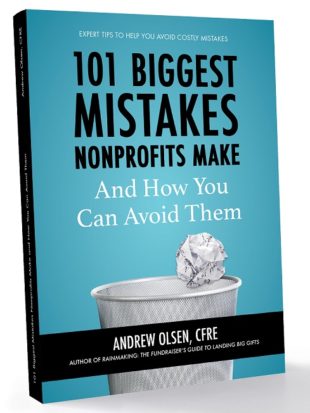
By Andrew Olsen, CFRE
In my upcoming book, The 101 Biggest Mistakes Nonprofits Make and How You Can Avoid Them, I brought together 25 industry veterans with more than 300 years of experience in leadership, strategy, program development and execution, marketing, and philanthropy to share the 101 biggest mistakes we make in our sector. And to give you a road map for how you can avoid making those same mistakes.
Today I’m highlighting five of the biggest mistakes that have a major impact on organizational success.
I hope these help you navigate your organization more successfully!
Mistake #1: Not Valuing Excellence
A better way to say this might be that you are willing to accept mediocrity. When this unfortunate mindset takes root it can become part of organizational DNA, and do real damage. It impacts the quality of hires you make, how you set goals and measure success, and the level to which you are able to deliver on mission objectives.
Here are two ways to overcome this challenge:
- Increase organizational accountability
- Set clear, realistic expectations
- Hold yourself, your executive team, and your staff accountable to those expectations
- Don’t punish people for missing a target – instead, help them learn, adapt, and re-calibrate for future success
- Focus on more and better training
- Our industry often overlooks training due to time constraints, cost, or both. Big mistake.
- Start by providing more and better training at the point of onboarding
- Provide more regular skills-based and role-based training for staff
- As a supervisor, give feedback and course correct in the moment rather than waiting until formal performance reviews
Mistake #2: Instilling Fear of Failure
Nonprofit organizations are largely risk averse. We operate within a construct that rewards slow, safe, incremental change rather than risk, innovation, and large-scale transformation. This limits most organizations from ever really achieving breakthrough results for their cause or those they serve. And it breeds a culture of fear of failure among many who work inside our organizations – and keeps them from doing things that would energize them professionally and create more positive impacts organizationally.
Here are five reasons you should consider cultivating a culture of healthy risk-taking in your org:
- It helps your people overcome fear of failure
- You spur more creative thinking
- It helps you surface and test previously unrealized opportunities
- Your people become more confident in their own thinking, skills, and abilities
- By testing, failing, and revising, your team learns new skills and strengthens old ones
Mistake #3: Hiring Untested, Unproven Major Gift Officers
Untested, unproven major gift officers are unfortunately too prevalent in our industry. I’m not talking about junior-level development staff who are just getting into the field and starting to learn their craft. Nope, I’m talking about people who have years “in the seat” but little to show for the time they’ve spent doing the work. You’ll know these people because for all of their years of experience across multiple organizations, they’re hard-pressed to point to a successful major gift program they’ve developed, to highlight key donor relationships they’ve personally cultivated, or gifts they’ve actually closed.
These are what my good friend and co-author of Rainmaking: The Fundraiser’s Guide to Landing Big Gifts, Roy C. Jones, CFRE (VP of Development at Mercy Ships) refers to as “Butterflies and Bumble Bees”. That’s because they flutter around an organization for a while looking busy, but once they depart for their next great opportunity, you feel the sting of them never actually having moved the needle for you on any key relationships or solicitations.
Don’t get stung by these unproven gift officers. Instead, screen your candidates more effectively by focusing on these seven qualities of high performing major gift officers:
- They are focused, active listeners
- They care deeply about people, and value the art of building long-term relationships
- They are passionate about their organization’s mission and values
- They are highly self-aware and self-disciplined
- They are results-driven
- They are resilient
- They are persistent, but don’t pester.
Mistake #4: Not Investing in a Strategic Planning Process
It’s shocking how many nonprofits don’t have a strategic plan or have never invested in a strategic planning process. Maybe there are an equal number of commercial businesses that operate without the benefit of a formal business plan. I don’t know. But either way, it’s risky.
Without a strategic plan there’s no way to tell what direction you’re headed, if you’re on track, behind, or maybe even ahead of where you should be today.
What I see is, most organizations that operation without a strategic plan are the ones that never really accomplish anything of significance. They don’t solve big problems or achieve big goals. They simply exist. And if you ask me, that’s wasted opportunity in many ways.
If you don’t have a strategic plan and don’t know how to start, I’d suggest you take these six steps:
- Understand your reality: Where is your organization today? Where are you in your organizational lifecycle? What’s working? What isn’t? Where do you have room to improve?
- Define your goals: What must you accomplish for your organization to be considered successful? What will happen for those you serve, for your staff, your community, and yourself when you’re successful? What happens if you aren’t?
- Define your priorities: What are the critical tasks and activities you must do? Why? What are the activities you’re spending time on now because they feel important, but they don’t actually contribute to achieving the goals you just outlined?
- Identify responsibilities and accountabilities: Create a list of the people who are ultimately accountable for each of the goals you identified. Then add names under each of those people to identify who is responsible for executing the work to achieve each of those goals. Now communicate those expectations, starting with your own personal accountabilities and responsibilities.
- Execute: Documenting your strategy is worthless if you never execute against it. Now’s the time to get to work!
- Measure and Pivot: Regularly revisit your strategic plan to make sure the ongoing work you’re doing is delivering your desired results. If your work isn’t helping achieve those goals, you need to modify what you’re doing, or reassess your goals.
Mistake #5: Letting “Who Gets the Credit” Dictate Your Fundraising Approach
Imagine this scenario…
A Development Director asks for guidance on how he might generate additional revenue for his organization for the year without making any additional investments.
An experienced consultant (ok, or maybe me!) responds with, Do these four things:
- Promote Donor Advised Fund (DAF) giving, because we know that when a donor makes a gift through her DAF, it has the potential to be 2X – 5X the size of a gift she might have given through cash or check.
- Promote stock or other asset giving, because again, we know that when donors give from assets other than cash, they tend to give more. And organizations that regularly promote stock giving see greater growth in income annually than those who don’t.
- Promote employer matching gifts, because, why not!?! If an employer will match the $100 gift their employee just gave you, that’s free money!
- Distribute a list of your top 100 Annual Fund donors to your major gift staff and ask them to start making calls to see if you can engage some of these donors differently and lead them toward larger investments in your organization this year.
Now imagine this response (or maybe you don’t have to because you’ve already thought it because it happens in your organization too) …
Those are great ideas, but I can’t implement any of them because other teams get credit for those type of transactions. None of these will help me hit my goal, so I can’t afford to waste time on them.
This. Is. Pure. Insanity.
And it happens every day in thousands of nonprofit organizations.
Rules around who gets credit for what gifts an organization receives are important for ensuring that your staff are performing to expectations and that your fundraising investment dollars are being spent effectively. But you should never design a structure that is so rigid that it hurts your organizational bottom line.
If you want to raise the most money possible for your mission, you’ve got to align your incentives with the behaviors you want more of, and stop handcuffing your people with silly, unbendable rules around credit.
I hope you’ve enjoyed these 5 Big Mistakes Nonprofits Make, and that you’ve found value in our recommendations to avoid them.

For questions, or to get on the list to receive an advance copy of 101 Mistakes Nonprofits Make and How You Can Avoid Them, drop us a note at freshideas@newportone.com.
Quantities of advanced copies are limited while supplies last.
